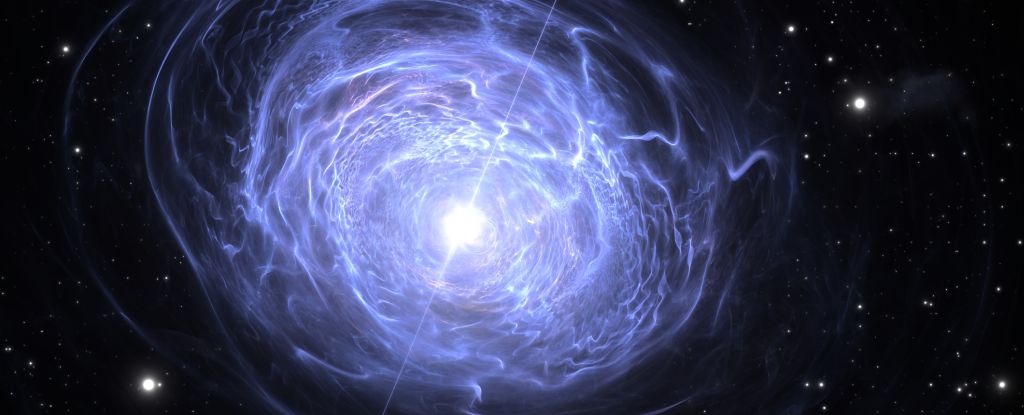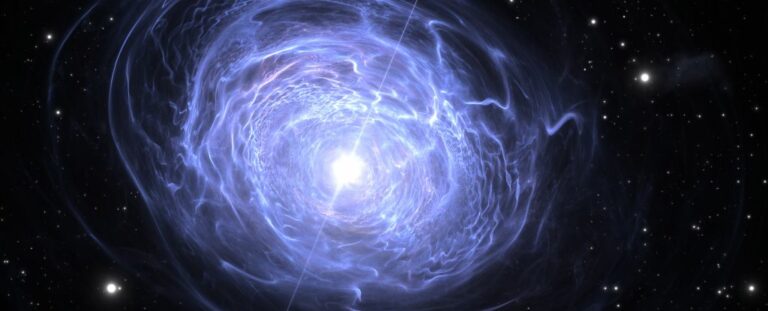Scientists are puzzled by an unusual radio signal originating from deep space.
Many people are worried because we have received an unusual signal from another part of the galaxy, which astronomers cannot decipher.

They understand what is sending out the signals. It is a neutron star called ASKAP J193505. 1+214841. 0 (ASKAP J1935+2148 for short) is in the Galactic plane and at a distance of 15. 820//light years from the Earth.
Of course, the signals themselves are unlike anything else that has ever existed in the universe. The star displays periods of active pulsations, periods of weak pulsations, and periods where pulsations are not observed.
From a team led by astrophysicist Manisha Caleb of the University of Sydney in Australia, we have answers to what, but what we do not know is why. The peculiar nature of the object raises an intriguing question on how neutron stars evolve – let’s face it, our current ideas about the subject are far from being very refined.
A neutron star is what’s left if a star of between 8 and 30 times the mass of the sun dies. This results in a process of shedding the outer material until a supernova explosion occurs, for the star.
The remaining core of the star collapses under the force of gravity becoming an ultra-dense object up to 2. Three solar masses in a sphere only 12 times the diameter of Earth.
The neutron star that results can then present in a variety of ways. First, we have the neutron star that goes about its business without much vigor. There’s the pulsar, which directs beams of radio emission from both poles as it spins, much like a lighthouse in the heavens.
There is the magnetar, a neutron star with an incredibly strong magnetic field, which spasms and explodes as the pressure from the outward motion of the magnetic field fights the gravity that binds the star together.
There can also be some special mixing of these neutron stars, which implies that these two are in different stages of neutron star development. Overall, though, pulsars, magnetars, and neutron stars are not outrageously different and usually act comparatively calmly.
ASKAP J1935+2148 does not act as a neutron star of any known categories, meaning it does not detonate in the conventional ways. It was discovered accidentally on an object of interest, and it was studied further using other instruments such as the Australian Square Kilometre Array Pathfinder (ASKAP) and the MeerKAT radio telescope in the South Africa.
The researchers also analyzed other ASKAP observations of the region done earlier for this study.
They established that ASKAP J1935+2148 has a sinusoidal variability pattern with a periodicity of about 53 pulses. Ten minutes… But that was the only thing that appeared to be quite recognizable and resembling the normal pulse rate in its fluctuations among all the tangled and round signals. The researchers discovered that one of the pulsation modes presented a strong brightness and had a highly linear polarity. It would then drop to no pulsation at all for a time and even if there was some, it would be very low and not measurable for a while.
Subsequently, the star was again found to pulsate but in a much lower luminosity state 26 times less than what was observed during its brighter phase and with a circularly polarized light.
The last few years have seen several rather peculiar objects with uniform pulsation detected in the southern part of the sky. They are not all likely to act in the same manner but it is possible that they are related.
GLEAM-X J162759. 5-523504. It is an object near the center of the galaxy that was observed to vomit bright flares for only three months before it ceased. GPM J1839-10 was discovered to function in a way like a bizarrely slow pulsar emitting flashes of radio signal every 22 minutes, with 5 minutes of emission. GCRT J1745-3009 is another pulsing object located within a region about the galactic center and has a cycle of seventy-seven mins.
As for what any of these objects might actually be, we aren’t entirely sure– neutron stars probably though. In this context, ASKAP J1935+2148, according to the authors Caleb and al. , may stand in between the distinct states.
Being derived from the specific pulsation modes, these differences can be related to magnetospheric variations and processes, and all the objects can be classified as belonging to magnetars, possibly transmuting to pulsars.
‘It seems that ASKAP J1935+2148 belongs to a population of magnetars with longer spin periods and lower X-ray luminosity but magnetically sufficient to produce the coherent radio emission’, authors state in their paper.
‘It is still essential that we explore this hitherto untapped area in neutron stars to get a broader overview of the evolution process of neutron stars and this may [well] be an important source to do that’.
The findings have been published in Nature Astronomy.
Do not forget to share your opinion with us to provide you with the best posts !




0 Comments